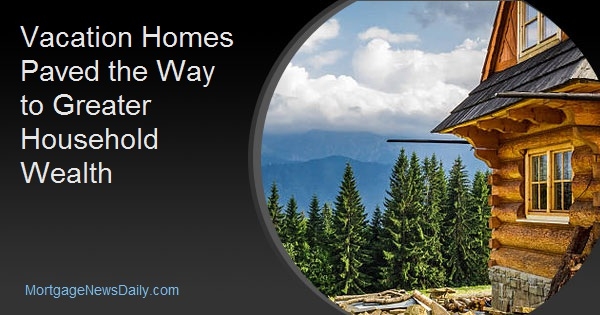While home prices have surged back from their housing crisis lows, a report from the National Association of Realtors® (NAR) says homes purchased as vacation properties have appreciated even more. NAR's 2019 Vacation Home Counties Report says that over the five years that ended in 2018, existing and new home prices gained an aggregate of 31 percent while the median price of a second home rose 36 percent. NAR found the areas with the greatest increases over the five-year span were in Pennsylvania, Wisconsin, and Massachusetts.
Lawrence Yun, NAR's chief economist, says the present figures are telling, especially when compared to data from 10 years prior. "As of 2018, household net worth reached an all-time high of $100.3 trillion - that's nearly double from a decade ago when wealth declined during the recession. Some of this tremendous growth in wealth, although concentrated, increased demand for vacation homes."
Price increased in both expensive and inexpensive areas. The study looks at properties on the county level provided by the Census Bureaus American Community Survey (ACS), concentrating on those considered "vacation home counties." These are counties where the vacant housing for seasonal, recreational or occasional use, made up 20 percent or more of the county's total housing stock. Of the nation's 3,141 counties, 206 counties (6.6 percent) met that criteria. NAR says that while most homebuyers are purchasing a primary residence, those who buy a second home do so for many reasons; to use as a general family vacation spot, a tenant rental, a means to gain equity, or - upon retirement - a future primary residence.
According to the NAR report, the top 26 vacation home counties - the counties with the largest percentages of vacant seasonal, recreational, or occasional use housing units - include those with nationally-known sites, as well as local destinations. Leading the list are counties in Massachusetts, New Jersey, and Colorado. These include counties with famous coastal areas like Nantucket and Martha's Vineyard, Cape Cod, and Cape May. Though less populated, there were also a lot of counties in northern Michigan, Wisconsin, and Minnesota.
"Some people may visualize the common popular vacation destinations in the U.S. when considering a vacation home, such as counties in Florida or California," says Yun. "And although those locations have their share of vacation properties, we see that some homeowners prefer some of the other counties, including those in Massachusetts and New Jersey. These areas are often known for harsh weather conditions but are popular nonetheless."
Some other notable vacation home counties are found in Maine, Pennsylvania, New York, New Hampshire, Maryland, Delaware, North Carolina, Vermont, Florida, California, Georgia, South Carolina, Arizona, Idaho and Oregon.
Using data from Black Knight property records, NAR also identified the most expensive and inexpensive locations for vacation homes. The most expensive home location in the U.S last year was Nantucket Island in Massachusetts, with a median sales price of $1 million. This is followed by other counties in Massachusetts, counties in the Rocky Mountains of Colorado, the Florida Keys, and California and Arizona counties near Yosemite National Park and the Grand Canyon respectively. NAR says, considering the 2018 2018 median sales price and the income of a typical family in the top 25 most expensive areas, a family earning the median income only - would be unable to afford to purchase a home in these counties.
However, Black Knight records show that the median price for a vacation home in many areas is less $100,000. The least expensive vacation home counties were found in Maine non-coastal areas of Maine, and in New York, Pennsylvania, Missouri, and Michigan.
Purchasing a median priced home in one of these areas with a 20 percent down payment would result in an annual mortgage payment less than $5,000. Under such a scenario, the mortgage payment would account for less than 10 percent of the income of a typical family that purchased a vacation home in one of the top least expensive vacation destination locations.
NAR found that buyers purchasing a vacation home with a mortgage typically make a 20 percent down payment. Most of the borrowers who obtained mortgages for second homes earned around $100,000 or more so among those borrowers the estimated mortgage payment to income ratio ranged from 4 percent to 12 percent in the vacation home counties







